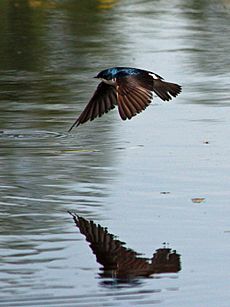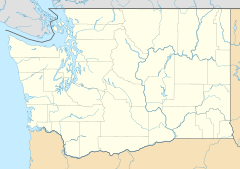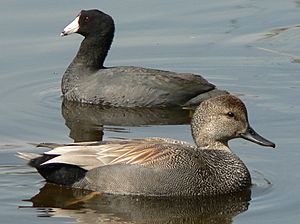Union Bay Natural Area facts for kids
Quick facts for kids Union Bay Natural Area |
|
|---|---|
| Location | Seattle, Washington, United States |
| Area | 50 acres (20 ha) |
| Established | 1972 |
| Governing body | University of Washington |
The Union Bay Natural Area (UBNA) in Seattle, Washington, is also known as Union Bay Marsh. It is a special place that used to be part of Union Bay and its marsh. This area was filled in long ago, and now it has been brought back to life. You can find it on the east side of the University of Washington campus. It is south of NE 45th Street and west of the Laurelhurst neighborhood.
Water from Ravenna Creek flows into a channel called University Slough. This channel then connects to Union Bay and finally to Lake Washington. The University Slough is one of several waterways that link the marsh to Lake Washington. It runs from NE 45th Street down to Union Bay.
Contents
Discovering the Union Bay Natural Area
The Union Bay Natural Area is about 50 acres big. It is a wonderful home for many animals and plants. This area has different types of habitats. These include small grasslands, ponds, and the shoreline of Lake Washington. It also has woods, a small prairie, and marshland.
A Home for Wildlife
The UBNA is a safe place for many birds. You might see double-crested cormorants, great blue herons, and even eagles. Turtles and frogs also live here. Because there are so many different habitats, it is a great spot for birdwatching. More than 150 types of birds have been seen here!
How the Area Changed Over Time
The land where UBNA is now used to be a large wetland. This changed when the Montlake Cut of the Lake Washington Ship Canal was opened in 1916. This canal lowered the water level of Lake Washington. After that, much of Union Bay was filled with trash from the Montlake Dump. This dump was used by the City of Seattle from 1911 to 1966.
The dump was closed in 1971. Then, two feet of clean soil were placed over it. Some of this land was used to build University Village, UW sports fields, and parking lots. The rest of the land became the Union Bay Natural Area. People sometimes call it "the fill" because it was built on filled land.

Waterways and Their History
Before Lake Washington's water level was lowered, Ravenna and Yesler Creeks flowed into the marshland. This was north of where the University Slough is today. The land where the slough is now was under the waters of Union Bay.
The Burke-Gilman Trail follows an old railway line. This line ran along the original shoreline of Union Bay. In 2006, a project helped reconnect Ravenna Creek to Union Bay. The creek now flows underground to the University Slough. This helps bring fresh water to the area.
Protecting the Union Bay Natural Area
The State of Washington owns the Union Bay Natural Area. The University of Washington helps manage it. Parts of the area are open to visitors during park hours. However, some parts are closed at certain times. This is to protect the animals and their homes.
Helping Nature Grow
Many projects take place at UBNA to help restore the natural environment. Volunteers work hard to remove plants that are not native to the area. These include Himalayan blackberry and morning glory. By removing these plants, they help the native plants grow better. This helps make the area a natural home for wildlife once again.



